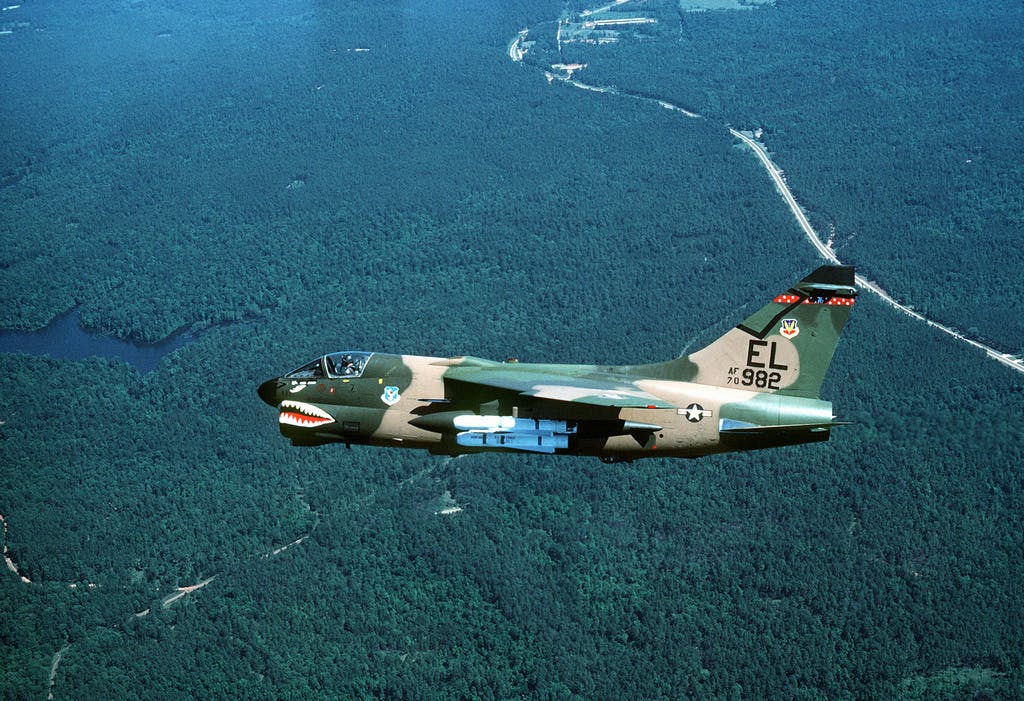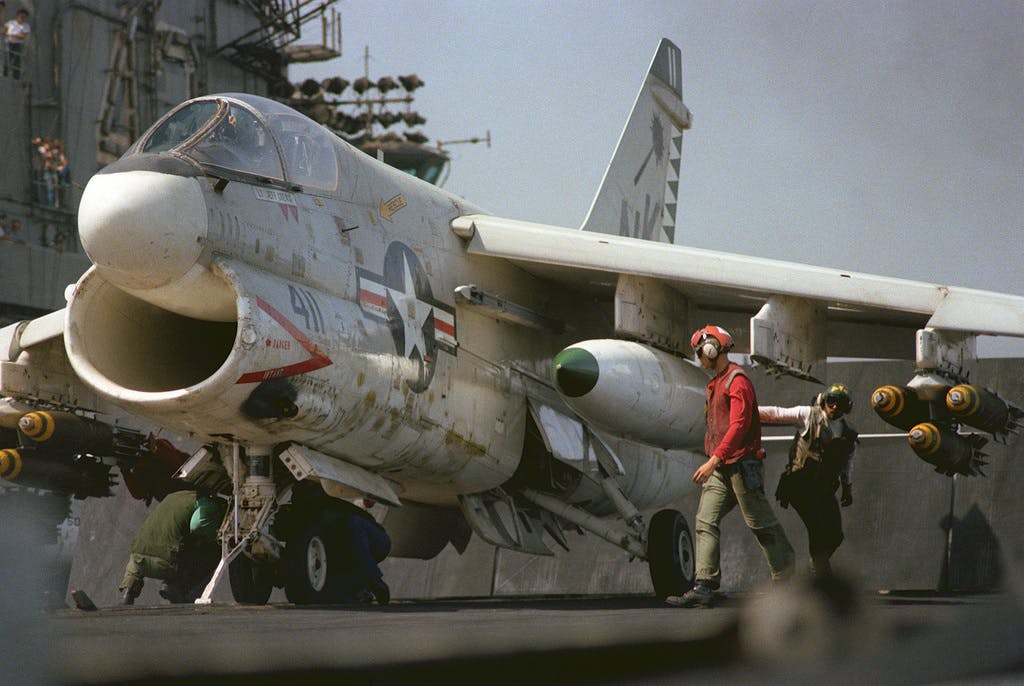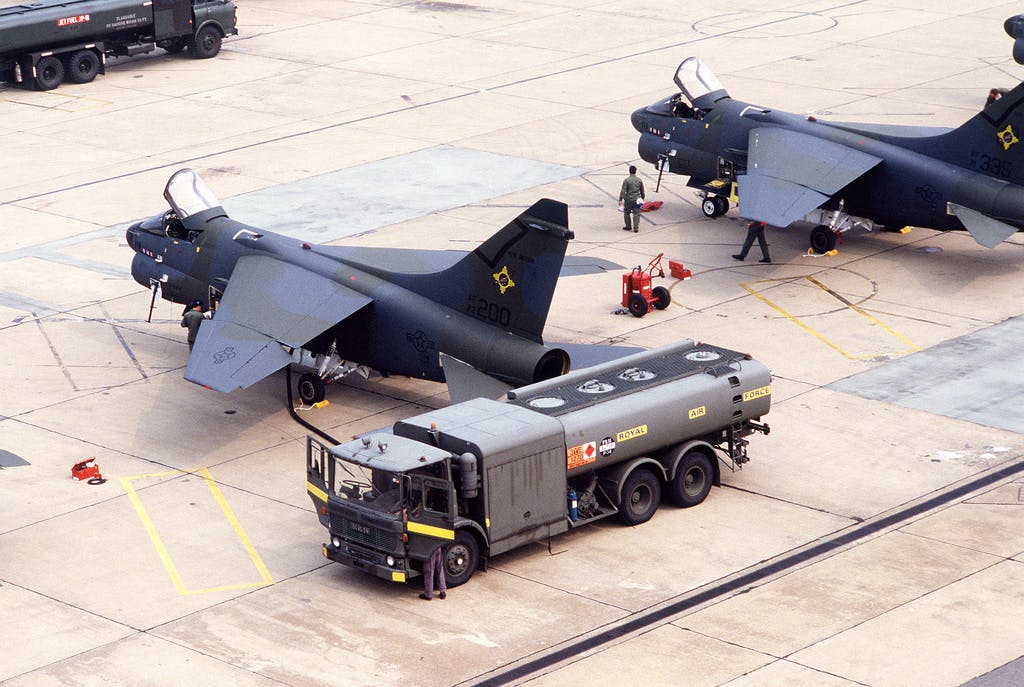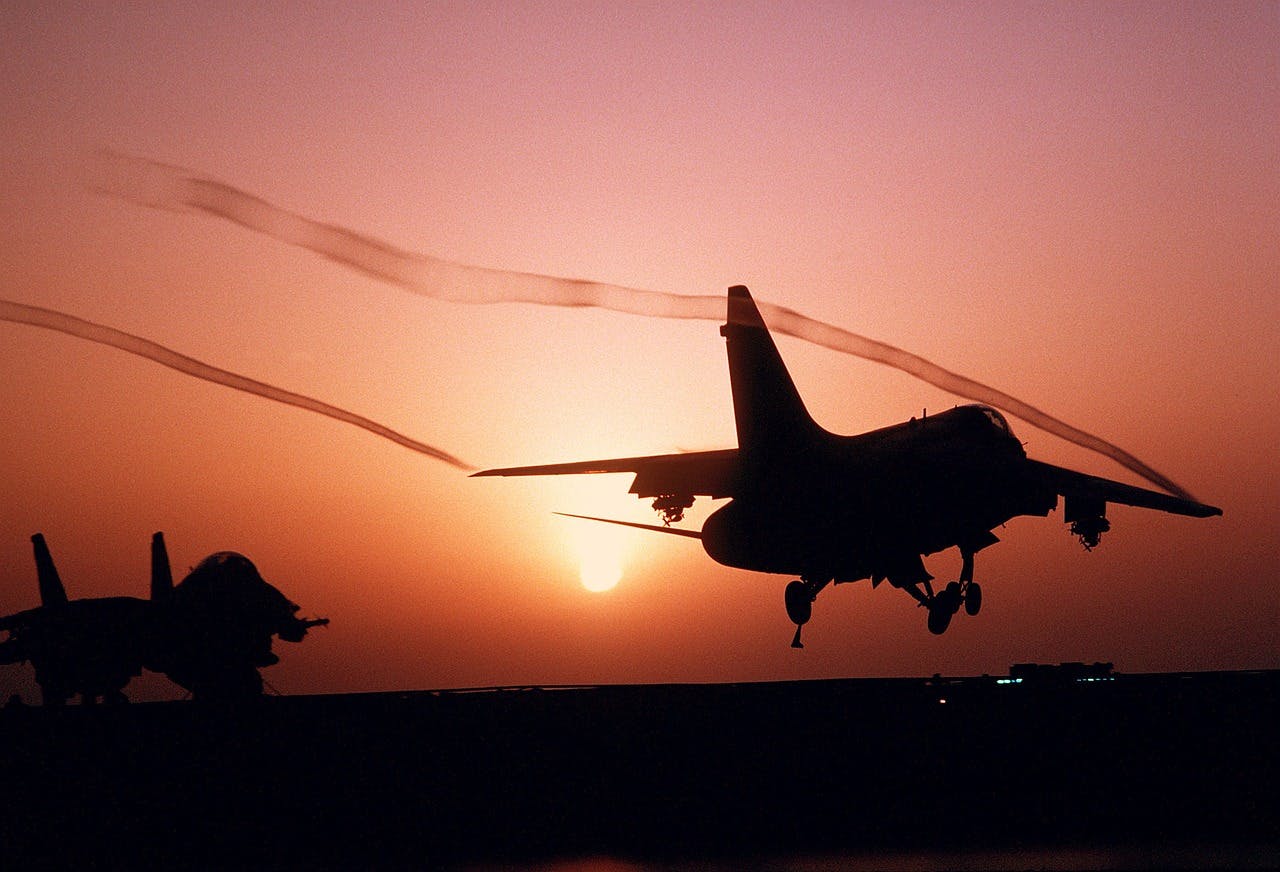A-7 Corsair II: Vietnam’s non-supersonic workhorse

Blog
In the 1950s, as the cold war heated up, America’s military aviation development program was all about “faster, higher, and more advanced.” As we tried to stay ahead of the communists, streamlined, supersonic interceptors, bombers, and fighters were the order of the day. It may seem strange, then, that as the Vietnam conflict grew from a war by proxy in the late 1950s to an “American boots on the ground” conflagration starting in 1965, it was a short, ugly, non-supersonic airplane designed by chopping down an existing airframe that became the much-loved and much-used workhorse in America’s strike-aircraft arsenal. In the skies over Vietnam (and for 25 years afterward), the Vought A-7 Corsair II was the aviation equivalent of a “utility player” in sports. It could do multiple jobs well, it was extremely reliable, and changed the nature of the game… but, unlike Ben Zobrist, it was inexpensive.
Let’s go over some of the key features and characteristics of this “boxy but good” light-attack aircraft and see if we can understand why it reached cult status among aviators and ground crews.

The problem with pushing the performance envelope
In the mid-20th century, as today, success in aerospace required innovation, pushing the performance envelope, and lots and lots of money. Developing the ultra-modern jet fighters, interceptors, and bombers that were predicted to fight World War III was a complicated and expensive proposition, particularly when this year’s top-of-the-line, multi-gazillion-dollar supersonic fighter was repeatedly made obsolete by next year’s new shiny. Then, as now, it took lots of expensive research to come up with cutting-edge designs, lots of expensive manufacturing techniques to develop and build them, and lots of expensive, highly trained maintenance crews and supply streams to keep them in the air.
By the 1960s, the US Navy, weary of chasing this expensive, inevitable obsolescence, and seeing the need for a less-complex and less-costly front-line strike aircraft that could be fielded in sufficient numbers to make a difference in a ground war, began to understand that supersonic capabilities were not necessary for a low-altitude strike aircraft. Maintaining myopic focus on supersonic performance increased development complexity and costs, but did little to improve the actual effectiveness of a light-attack aircraft intended to support a ground war in a place like Vietnam.

The US Navy makes a somewhat strange request: Make a slower, cheaper airplane
The Navy was also seeing the need to replace the well-liked but short-range A-4 Skyhawk (whose prototype first flew in 1954, with production aircraft delivered starting in 1956). The Skyhawk would continue serving for many years, and had the advantages of great reliability and flying characteristics, but with the downsides of a comparatively short range and light payload. After performing an intensive study and evaluating the needs of their commanders, the Navy issued a Request For Proposals (RFP) in May 1963 for industry design and prototype submissions of a subsonic attack aircraft based on an existing, proven airframe to save costs. This may have appeared like a bizarre step backward to the public or to uninformed industry big-wigs who assumed that bigger/faster/higher was always the right way to go, but it turned out to be an ingenious move that paid dividends for decades.
But the Navy’s request to start with an existing aircraft was not just a little strange, it was connected to a tall order. The RFP asked for an aircraft with at least twice the range of the soon-to-be-outgoing A4 Skyhawk, as well as twice its weapons payload. However, the new airplane also needed to be inexpensive to produce and maintain. Oh, and by the way, we want it yesterday. What’s the old business adage? “Faster, better, cheaper: pick two.” The Navy went with Better and Cheaper.
The Vought aircraft company (the same Vought that gained fame and fortune building the excellent F4U Corsair “gull-wing” fighter during WWII) had the idea to start with its current F-8 Crusader, which was a trusted and well-liked supersonic fighter-bomber but was expensive and relatively complicated to build and maintain. The project was given to Vought engineer John Russell “Russ” Clark, who assembled a team of true believers and submitted their proposal, and it was selected over the other competitors in February 1964. The first contract was awarded in March 1964. Just 18 months later on September 27, 1965, the first A-7 flew its maiden flight. On November 2, 1965, Vought publicly demonstrated the first pair of A-7s to VIP guests. During this flight demonstration, test pilot John Conrad showcased the new aircraft’s ability to perform rapid rolls even with a huge payload of six 250-lb and twelve 500-lb bombs mounted beneath its wings. At that time, a Navy spokesperson also confirmed the A-7’s ability to carry double the bomb load of an A-4E Skyhawk, or the same payload over twice its maximum distance.
Clark and his crew had hit one out of the park with the A-7. By starting with the proven F-8 airframe, removing the Crusader’s complicated variable-incidence wing design (which pivoted by 7° out of the fuselage on takeoff and landing to improve carrier operations and keep the fuselage more level), chopping out 10 feet of length, installing a non-afterburning Pratt & Whitney TF30-P-6 turbofan engine, and beefing up the wing sections, avionics, hydraulics, and armor, Vought was able to go from theoretical concepts and paper contracts to fully functional, pre-production demonstrator aircraft in less than two years, and full production began quickly. By the end of 1965, 200 A-7s had been ordered by the Navy, and the platform proved so effective that eventually over 1,560 were built.
The overall profile of the Corsair II looked very similar to an F-8 Crusader that had been horizontally scaled to 70%. Vought’s designers retained the Crusader’s gape-mouthed front air intake under the nose, abbreviated the nose cone further, and fattened up the shorter fuselage. They ended up with a relatively short strike aircraft at a tad over 46 feet long, with a wingspan of just over 38.5 feet. Compare that to the 63-foot long F-4 Phantom or even the 56-foot-long F8-U Crusader that was the basis for the Corsair II’s airframe, and you start to understand why Navy ground crews and aviators referred to the plane as the “The Harley,” “The SLUF (Short Little Ugly F*****),” or “The Gator.”

What made the A-7 Corsair II so good?
A-7 pilots, crews, and unit commanders eventually became so enamored of the stubby, strange-looking plane that outspoken fans of the platform began to be known as the “A-7 mafia.” But what exactly did they like about the Corsair II that merited such devotion? Let’s go over the high points.
Excellent flying characteristics and combat survivability
From day one, pilots loved flying the A-7, despite its “underpowered” initial powerplant. Naval aviators (and later Air Force pilots) lauded the A-7’s neutral flying characteristics, ease of flight, fully powered controls, and excellent frontal visibility. The armored-up portions of the airframe and vital systems, combined with triple-redundant hydraulic systems for the flight control surfaces, gave flyers the confidence to get close to the action for pinpoint strikes, knowing that the A-7 would most likely get them home after the mission.
The Corsair II was no dogfighter, particularly without afterburner capability, and pilots had to sacrifice altitude for speed to evade enemy fighters. However, it did have 2 20mm Colt Mk 12 cannons (later swapped for a single Vulcan rotary cannon) and provision for air-to-air missiles, so in the hands of a good pilot the A-7 could make a good showing for itself. It was in the close air support and light bombing/strike role that the A-7 shone, though.
The Corsair II first flew in combat missions in May 1970, but due to the aircraft’s excellent reliability and survivability, the A-7 fleet managed an incredible mission cadence. Corsair IIs fielded by the Navy/Marines flew more than 97,000 combat sorties in Vietnam, experiencing just 54 losses. The USAF’s fleet of A-7Ds flew a total of 12,928 combat sorties during the war with only six losses—the lowest of any US fighter/bomber in the theater.
Combat range and payload
One well-reputed internet source makes the ridiculous claim that the A-7 had a range of 8,800 miles and could carry 20,000 lbs of ordnance. In reality, the Corsair II didn’t fly quite that far on a tank of fuel, but its operational combat range of over 1,200 miles and capability of carrying up to 15,000 lbs of bombs, rockets, and missiles was still impressive. Maximum “ferry range” of the A-7 was 1,544 miles with a maximum internal and external fuel load. A-4 variants of the time had a combat range of around 700 miles, with a maximum weapons loadout of 8,500 lbs.
Improved reliability and reduced operational costs
A-7As cost a little over $1 million per copy at the time, which was a relative bargain, considering that the F-4 Phantom variants were around $2 million per unit in 1965 dollars. Additionally, the A-7’s non-afterburning turbofan engine demonstrated remarkable increases in fuel efficiency compared with earlier turbojets. The initial Pratt & Whitney engine was found to be inadequate, and at least 3 other engines from various manufacturers were used throughout the Corsair II’s service life, but all were non-afterburning turbofans. The A-7D variant had specific fuel consumption one-sixth that of an F-100 Super Sabre at equivalent thrust.
Furthermore, an A-7D carrying twelve 500-lb bombs at 480 mph at 33,000 feet used only 3,350 pounds of fuel per hour, which contributed to the Corsair II’s excellent range. Typical fuel consumption of the Corsair II during aircraft-carrier recovery operations was approximately 30 pounds per minute, compared to over 100 pounds per minute for the larger, twin-engine, supersonic F-4 Phantom.
The A-7 proved more reliable than even the F-8 Crusader on which it was based, and the A-7 didn’t suffer the persistent hydraulic leaks that plagued its parent aircraft. Engine replacements and maintenance on the Corsair II were much easier and less time-consuming than on the A-4 it replaced.
Excellent avionics and weapons package
The A-7 had top-of-the line avionics for the time, and was the first US aircraft to have a modern-style “heads-up” display for the pilot, which was so useful and effective that it was a “must-have” on every combat aircraft since. The A-7 was capable of making extremely accurate dive strikes using conventional bombs or the new AGM-62 Walleye TV-guided glide bomb, which was one of the first “fire and forget,” self-guided bombs fielded by the USA.
The Corsair II was second only to the Boeing B-52 Stratofortress in the amount of ordnance dropped on Hanoi, and A-7s dropped more bombs per sortie with greater accuracy than any other US attack aircraft during the war.
All of this added up to an aircraft that, despite its funky, chunky, largemouth-bass looks was beloved of its pilots and crews, and ended up serving faithfully over an impressive, 25-year service life. Upgrades over the years kept the A-7 viable, and after Vietnam it flew combat missions over Grenada, Lebanon, Libya, Panama, and Operation Desert Storm. Even after the US officially retired the platform, A-7s were fielded by Portugal and Greece until 1999 and 2014, respectively.
It just goes to show that sometimes, being useful is better than looking good. Some of us take comfort in that.
–By Jeff Davis, Intergalactic Scribe
Sources:
https://www.navalaviationmuseum.org/a-closer-look-the-a-7-corsair-ii/